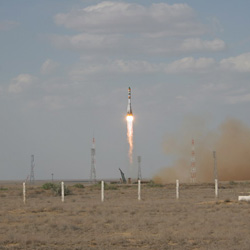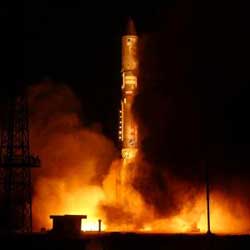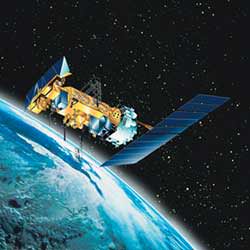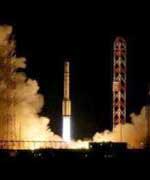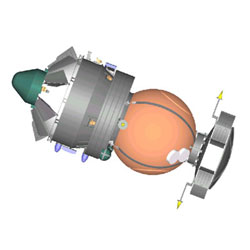
Computer illustration of the Foton-M2 satellite. Image credit: ESA. Click to enlarge.
The re-entry module of the Foton-M2 spacecraft, which has been in low-Earth orbit for the last 16 days made a successful landing today in an uninhabited area 140 km south-east of the town of Kostanay in Kazakhstan, close to the Russian border at 09:37 Central European Time, 13:37 local time.
The unmanned Foton-M spacecraft, which was launched on 31 May from the Baikonur Cosmodrome in Kazakhstan, carried a European payload of 385 kg covering 39 experiments in fluid physics, biology, crystal growth, meteoritics, radiation dosimetry and exobiology.
All de-orbit to landing procedures went according to plan beginning with the jettison of the Foton-M2 battery module three hours prior to landing. At an altitude of about 300 kilometres, travelling at 7.8 km/s and 30 minutes prior to landing, the retro-rocket situated on the Foton service module was fired for 45 seconds slowing the spacecraft down to reduce its altitude. The Foton-M2 service module was hereafter separated from the re-entry module and, as planned, burnt up in Earth?s atmosphere.
Twenty minutes prior to landing the spherical re-entry module entered the stratosphere, experiencing temperatures up to 2000?C and an acceleration of up to 9g. At 8.5 minutes before landing, the drogue parachute was deployed, which in turn opened the brake parachute, reducing the descent speed from supersonic to subsonic. The main parachute was deployed thirty seconds later, at an altitude of 2.5 km, reducing the speed of the re-entry module to 10 m/s. Brake rockets finally reduced the speed of the re-entry module to 3 m/s, 0.35 seconds before landing impact.
ESA representatives were on hand at the landing site to undertake initial procedures related to European experiments. This included immediate retrieval of the Biopan, Stone and Autonomous Experiments. The same team removed the FluidPac experiment facility?s digital tape recorder and configured FluidPac for safe transport to the TsSKB-Progress factory in Samara. The Foton capsule is currently being transported to Samara where the FluidPac facility and the Telescience Support Unit will be removed from the capsule and shipped to ESA/ESTEC in Noordwijk, the Netherlands.
?I am extremely pleased that the majority of experiments have performed well.? said ESA?s Project Manager for Foton missions, Antonio Verga. ?My thanks to the ESA Operations Team who has closely followed the mission from the Payload Operations Centre at Esrange in Kiruna, Sweden and our Russian counterparts at Roskosmos, TsSKB-Progress and the Barmin Design Bureau for General Engineering. The hard work and dedication of everyone involved has been crucial in making this mission a success and optimising the scientific returns from the mission?.
The Foton-M2 staff at Esrange, consisted of a team of 30 scientists, engineers and operators who worked in close coordination with the Mission Operation Centre at TsSKB, Samara, and with the Flight Control Centre in Moscow, which continuously reported and informed about the orbital phases of Foton-M2, via a powerful and effective data network operated and maintained by ESA?s European Space Operations Centre (ESOC) in Darmstadt, Germany.
Fluid physics experiments were conducted in the FluidPac and SCCO experiment facilities. The data return from these was nearly complete and most of the scientific objectives were achieved. The BAMBI experiment produced some excellent images, a substantial role in which was played by the on-line processing capability of TeleSupport Unit.
The Agat furnace performed flawlessly as well. The processed samples should provide the material science community with good specimens to analyse. Unfortunately, the Russian Polizon furnace suffered a failure due to as yet unknown reasons, which prevented the processing of the semiconductor alloys stored in its drum at the required high temperatures.
The very successful technology experiment MiniTherm was performed during the mission, which deals with the performance of a new design of heat pipes. This experiment was controlled from Esrange, during its 5 days-long execution.
Also numerous experiments attached to the outside of the Foton satellite were performed, which deal with space exposure and technology aspects.
The European Space Agency has been participating in this type of scientific mission for 18 years and with a total of 385 kg of European experiments and equipment, this mission constituted the largest European payload that has been put into orbit.
“The Foton-M2 mission has been a resounding success and I look forward to seeing the positive impact the results of the experiments will have in the future,? said Daniel Sacotte, ESA?s Director of Human Spaceflight, Microgravity and Exploration Programmes. ?I also look forward to building on this success with the Foton-M3 mission, which is planned to be launched in 2007.?
For more information on the Foton-M2 mission and the status of the ESA experiments: http://www.spaceflight.esa.int/foton
Original Source: ESA News Release

